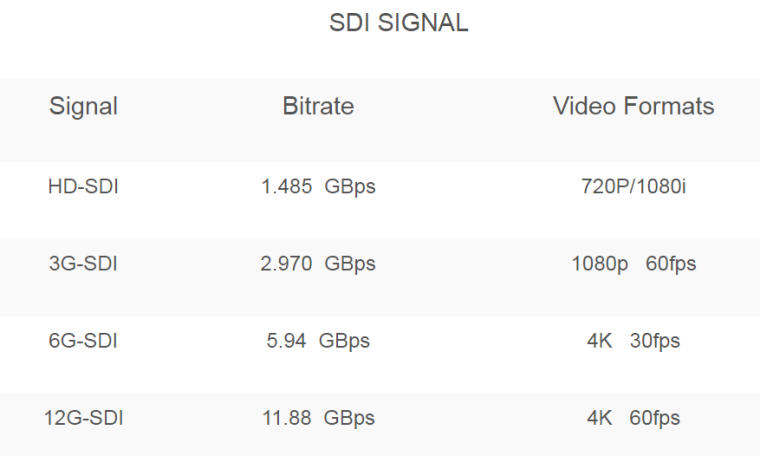The SDI (Serial Digital Interface) is a family of digital video interfaces (SDI, HD-SDI, 3G-SDI, 6G-SDI and 12G-SDI), that was first standardized in 1989 by SMPTE (The Society of Motion Picture and Television Engineers). The standard has been widely adopted by the broadcast industry, and is used for transmission of uncompressed, unencrypted digital video signals in TV studios and facilities. The SDI standard, however, is not limited to uncompressed content.
SDI and HD-SDI have traditionally only been available in professional video equipment, owing to licensing agreements that restricted use in semi-professional AV equipment, as well as consumer equipment.
As the world evolves, so has the SDI standard. Additional versions of the SDI standard have been developed to support continuously increased resolutions (HD, UHD, 4K, 8K), higher bitrates and more colors.
Before digging into the details of the various SDI standards, let’s take a look at one of the most important parameters of the standard: the bitrate (bandwidth). The bitrate describes the rate of bits being transferred from one source to another - it measures how much data is transmitted in a given amount of time. Bitrates are most often measured in bits per second (bps), kilobits per second (Kbps), megabits per second (Mbps) or gigabits per second (Gbps). The bitrates in the SDI standards are listed as the maximum bitrate the standard supports and are closely correlated to the video resolutions.
SD-SDI (SMPTE 259M)
The SD-SDI is the first version of the standard and was introduced in 1989. It supports resolutions up to 576i (NTSC and PAL compatible resolutions at 25 frames per second) and four different bitrates: 270 Mbit/s, 360 Mbit/s, 143 Mbit/s, and 177 Mbit/s.
The 270 Mbit/s is by far the most widely used as it is the PAL/NTSC standard. The widescreen version of the standard was introduced later supporting bandwidths up to 360 Mbit/s.
HD-SDI (SMPTE 292M)
HD-SDI arrived in 1998 following the introduction of HD resolution (720p and 1080i). It supports bitrates up to 1,5 Gbit/s (1.485 Gbit/s and 1.485/1.001 Gbit/s). The latter, with a factor of 1/1.001 was created, allowing the HD-SDI standard to support video formats with frame rates of 59.94 Hz, 29.97 Hz, and 23.98 Hz. This was to maintain support of a wide number of existing NTSC systems.
3G-SDI (SMPTE 424M, 424:2012)
The 3G-SDI is a 3 Gbit/s interface (more accurately, 2.970 Gbit/s, and 2.970/1.001 Gbit/s) that was standardized in 2006. It was revised in 2012 (SMPTE ST 424M:2012) to support all the same features as the Dual Link HD-SDI 1.485 Gbit/s interface, but in this version the implementation requires one cable, compared to two in the previous standard.
6G-SDI (SMPTE ST-2081)
The 6G-SDI is a 6Gbit/s interface (5.940 Gb/s or 5.940/1.001 Gb/s) and it supports 4K 30 frames on a single link, and was announced as a standard in 2015, the SMPTE ST-2081.
With the continuous growth and widespread use of 4K, this was a natural development of the SDI family. It was previously possible to use 4 x HD-SDI signals to transmit 4K at 30 frames or 4 x 3G-SDI signals to transmit 4K up to 60 frames per second, but with 6G-SDI this is done by a single or dual link.
Note that there two 4K standards, UHD and DCI – both defined by SMPTE. Let’s take a brief look at the difference between the two 4K standards:
3840 x 2160 (UHD, UHD-TV) is the 4K resolution used in broadcast and the world of TV. The resolution is exactly corresponding to 4 x HD (1920x1080). The UHD format is also a SMPTE standard (2036-1).
4096 x 2160 (DCI, Digital Cinema Initiative) is the 4K resolution adopted by digital cinema. Where UHD matches 4 x HD signals, the 4K DCI is 4 x 2K (2048x1080). The 4K DCI format is also standardized by SMPTE (2048-1).
12G-SDI (SMPTE ST-2082)
The first version of the 12G-SDI standard was introduced simultaneously with the 6G-SDI interface in 2015. It was revised in 2018 (ST 2082-10:2018) and covers Standard Dynamic Range (SDR) and High Dynamic Range (HDR) Source image formats into single or multiplex 12G-SDI 10-bit interfaces. Owing to the higher bitrates allowed in the standard, 12G-SDI supports 4K 60 from a single link and 8K 30 from a dual.
